TLH302 - Strategic Planning for Tourism: A Case Study of Deal, UK
VerifiedAdded on 2023/06/18
|13
|5023
|431
Report
AI Summary
This report provides a strategic tourism plan for Deal, a coastal town in Kent, England, focusing on addressing the challenges and issues it faces, particularly in the wake of the COVID-19 pandemic. It highlights the benefits of strategic planning, including economic development, foreign exchange income, and improved coastal areas. The report also evaluates the importance of collaborative planning, emphasizing its role in sustainable development, effective solutions, tourism promotion, and information provision. A brief tourism strategy is outlined, setting a vision and objectives for Deal, considering its strengths and addressing current challenges. The report further discusses the implementation of these objectives and vision, and evaluates the strategy's benefits for residents and visitors, both socially and economically. The plan aims to revitalize Deal as a tourist destination while ensuring sustainability and community well-being. Desklib offers more solved assignments and past papers for students.
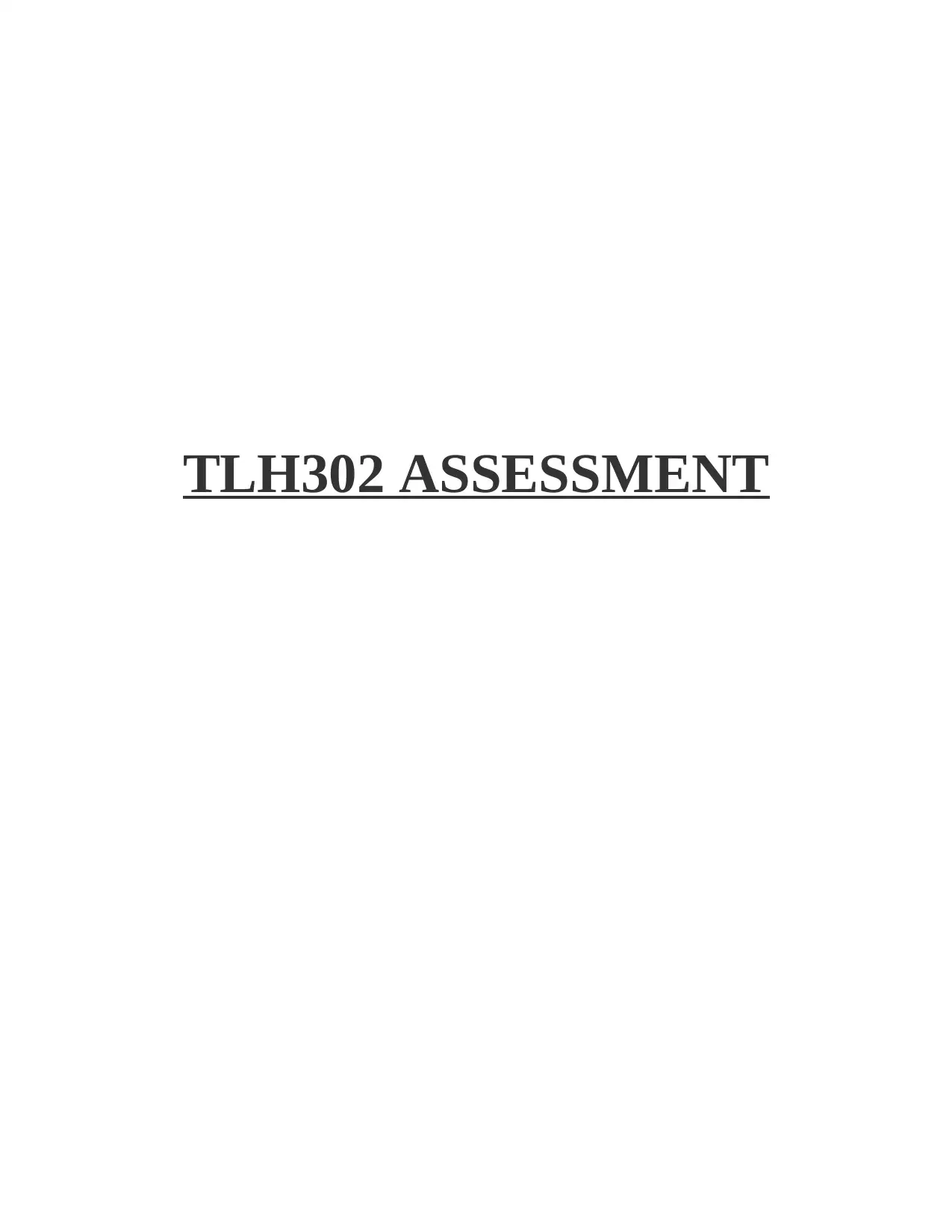
TLH302 ASSESSMENT
Paraphrase This Document
Need a fresh take? Get an instant paraphrase of this document with our AI Paraphraser
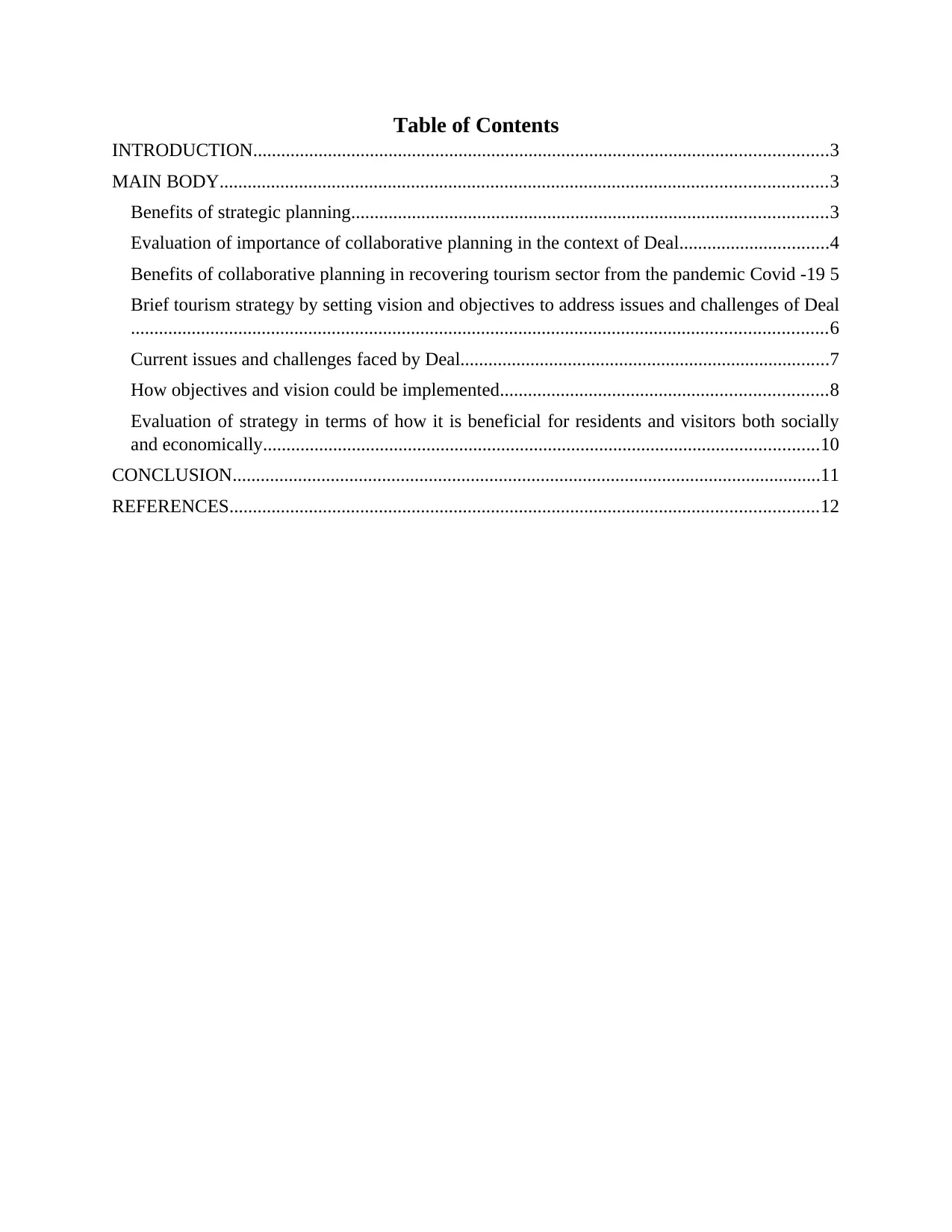
Table of Contents
INTRODUCTION...........................................................................................................................3
MAIN BODY..................................................................................................................................3
Benefits of strategic planning......................................................................................................3
Evaluation of importance of collaborative planning in the context of Deal................................4
Benefits of collaborative planning in recovering tourism sector from the pandemic Covid -19 5
Brief tourism strategy by setting vision and objectives to address issues and challenges of Deal
.....................................................................................................................................................6
Current issues and challenges faced by Deal...............................................................................7
How objectives and vision could be implemented......................................................................8
Evaluation of strategy in terms of how it is beneficial for residents and visitors both socially
and economically.......................................................................................................................10
CONCLUSION..............................................................................................................................11
REFERENCES..............................................................................................................................12
INTRODUCTION...........................................................................................................................3
MAIN BODY..................................................................................................................................3
Benefits of strategic planning......................................................................................................3
Evaluation of importance of collaborative planning in the context of Deal................................4
Benefits of collaborative planning in recovering tourism sector from the pandemic Covid -19 5
Brief tourism strategy by setting vision and objectives to address issues and challenges of Deal
.....................................................................................................................................................6
Current issues and challenges faced by Deal...............................................................................7
How objectives and vision could be implemented......................................................................8
Evaluation of strategy in terms of how it is beneficial for residents and visitors both socially
and economically.......................................................................................................................10
CONCLUSION..............................................................................................................................11
REFERENCES..............................................................................................................................12
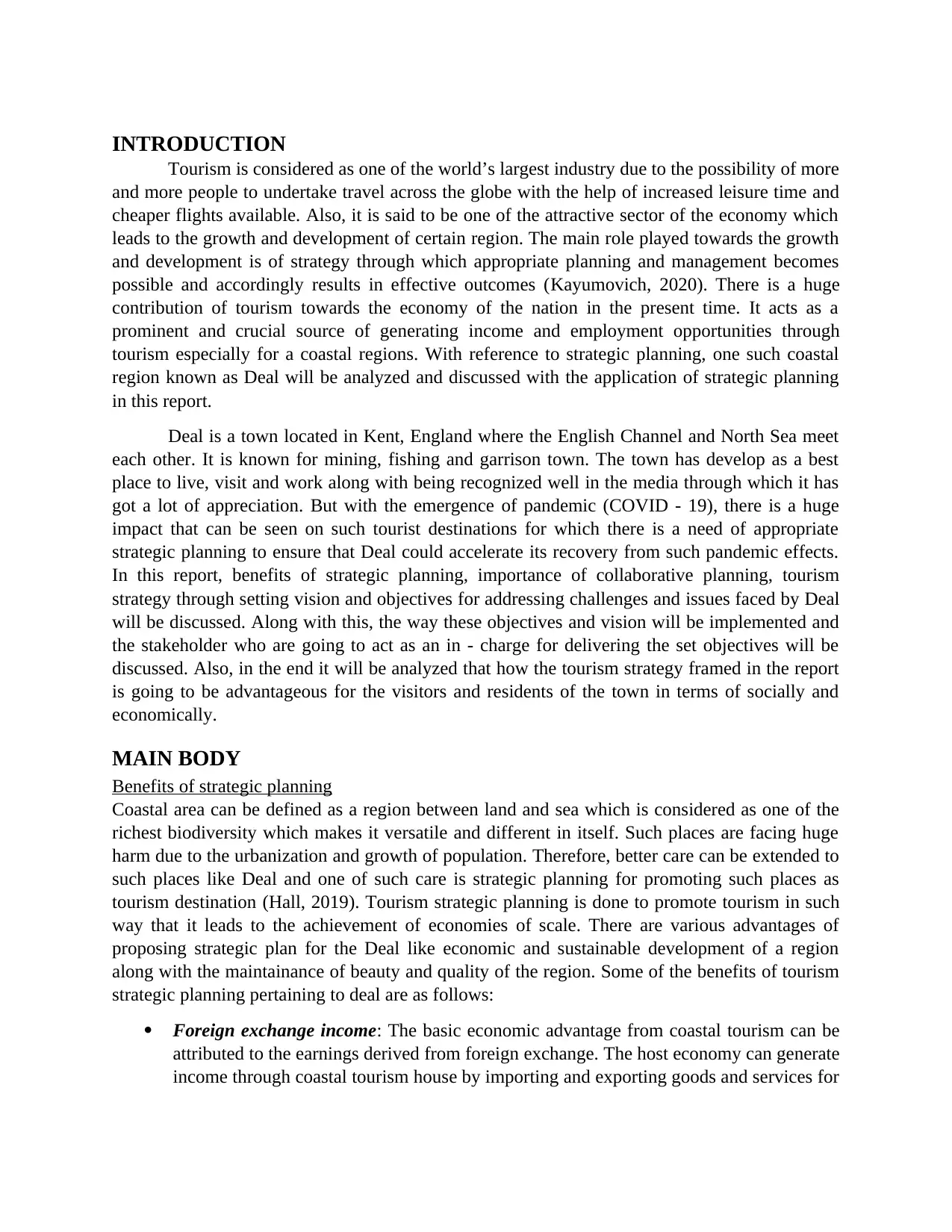
INTRODUCTION
Tourism is considered as one of the world’s largest industry due to the possibility of more
and more people to undertake travel across the globe with the help of increased leisure time and
cheaper flights available. Also, it is said to be one of the attractive sector of the economy which
leads to the growth and development of certain region. The main role played towards the growth
and development is of strategy through which appropriate planning and management becomes
possible and accordingly results in effective outcomes (Kayumovich, 2020). There is a huge
contribution of tourism towards the economy of the nation in the present time. It acts as a
prominent and crucial source of generating income and employment opportunities through
tourism especially for a coastal regions. With reference to strategic planning, one such coastal
region known as Deal will be analyzed and discussed with the application of strategic planning
in this report.
Deal is a town located in Kent, England where the English Channel and North Sea meet
each other. It is known for mining, fishing and garrison town. The town has develop as a best
place to live, visit and work along with being recognized well in the media through which it has
got a lot of appreciation. But with the emergence of pandemic (COVID - 19), there is a huge
impact that can be seen on such tourist destinations for which there is a need of appropriate
strategic planning to ensure that Deal could accelerate its recovery from such pandemic effects.
In this report, benefits of strategic planning, importance of collaborative planning, tourism
strategy through setting vision and objectives for addressing challenges and issues faced by Deal
will be discussed. Along with this, the way these objectives and vision will be implemented and
the stakeholder who are going to act as an in - charge for delivering the set objectives will be
discussed. Also, in the end it will be analyzed that how the tourism strategy framed in the report
is going to be advantageous for the visitors and residents of the town in terms of socially and
economically.
MAIN BODY
Benefits of strategic planning
Coastal area can be defined as a region between land and sea which is considered as one of the
richest biodiversity which makes it versatile and different in itself. Such places are facing huge
harm due to the urbanization and growth of population. Therefore, better care can be extended to
such places like Deal and one of such care is strategic planning for promoting such places as
tourism destination (Hall, 2019). Tourism strategic planning is done to promote tourism in such
way that it leads to the achievement of economies of scale. There are various advantages of
proposing strategic plan for the Deal like economic and sustainable development of a region
along with the maintainance of beauty and quality of the region. Some of the benefits of tourism
strategic planning pertaining to deal are as follows:
Foreign exchange income: The basic economic advantage from coastal tourism can be
attributed to the earnings derived from foreign exchange. The host economy can generate
income through coastal tourism house by importing and exporting goods and services for
Tourism is considered as one of the world’s largest industry due to the possibility of more
and more people to undertake travel across the globe with the help of increased leisure time and
cheaper flights available. Also, it is said to be one of the attractive sector of the economy which
leads to the growth and development of certain region. The main role played towards the growth
and development is of strategy through which appropriate planning and management becomes
possible and accordingly results in effective outcomes (Kayumovich, 2020). There is a huge
contribution of tourism towards the economy of the nation in the present time. It acts as a
prominent and crucial source of generating income and employment opportunities through
tourism especially for a coastal regions. With reference to strategic planning, one such coastal
region known as Deal will be analyzed and discussed with the application of strategic planning
in this report.
Deal is a town located in Kent, England where the English Channel and North Sea meet
each other. It is known for mining, fishing and garrison town. The town has develop as a best
place to live, visit and work along with being recognized well in the media through which it has
got a lot of appreciation. But with the emergence of pandemic (COVID - 19), there is a huge
impact that can be seen on such tourist destinations for which there is a need of appropriate
strategic planning to ensure that Deal could accelerate its recovery from such pandemic effects.
In this report, benefits of strategic planning, importance of collaborative planning, tourism
strategy through setting vision and objectives for addressing challenges and issues faced by Deal
will be discussed. Along with this, the way these objectives and vision will be implemented and
the stakeholder who are going to act as an in - charge for delivering the set objectives will be
discussed. Also, in the end it will be analyzed that how the tourism strategy framed in the report
is going to be advantageous for the visitors and residents of the town in terms of socially and
economically.
MAIN BODY
Benefits of strategic planning
Coastal area can be defined as a region between land and sea which is considered as one of the
richest biodiversity which makes it versatile and different in itself. Such places are facing huge
harm due to the urbanization and growth of population. Therefore, better care can be extended to
such places like Deal and one of such care is strategic planning for promoting such places as
tourism destination (Hall, 2019). Tourism strategic planning is done to promote tourism in such
way that it leads to the achievement of economies of scale. There are various advantages of
proposing strategic plan for the Deal like economic and sustainable development of a region
along with the maintainance of beauty and quality of the region. Some of the benefits of tourism
strategic planning pertaining to deal are as follows:
Foreign exchange income: The basic economic advantage from coastal tourism can be
attributed to the earnings derived from foreign exchange. The host economy can generate
income through coastal tourism house by importing and exporting goods and services for
⊘ This is a preview!⊘
Do you want full access?
Subscribe today to unlock all pages.

Trusted by 1+ million students worldwide
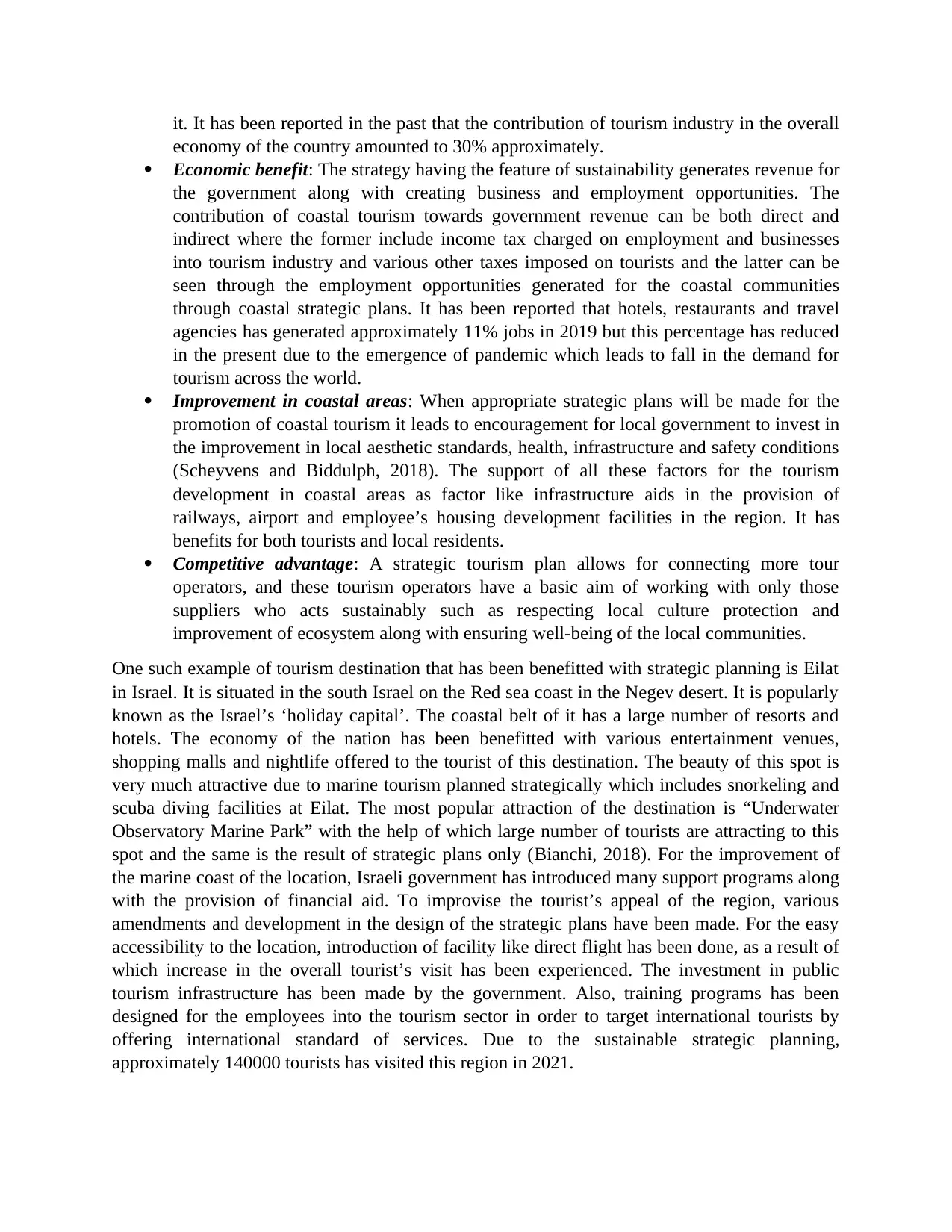
it. It has been reported in the past that the contribution of tourism industry in the overall
economy of the country amounted to 30% approximately.
Economic benefit: The strategy having the feature of sustainability generates revenue for
the government along with creating business and employment opportunities. The
contribution of coastal tourism towards government revenue can be both direct and
indirect where the former include income tax charged on employment and businesses
into tourism industry and various other taxes imposed on tourists and the latter can be
seen through the employment opportunities generated for the coastal communities
through coastal strategic plans. It has been reported that hotels, restaurants and travel
agencies has generated approximately 11% jobs in 2019 but this percentage has reduced
in the present due to the emergence of pandemic which leads to fall in the demand for
tourism across the world.
Improvement in coastal areas: When appropriate strategic plans will be made for the
promotion of coastal tourism it leads to encouragement for local government to invest in
the improvement in local aesthetic standards, health, infrastructure and safety conditions
(Scheyvens and Biddulph, 2018). The support of all these factors for the tourism
development in coastal areas as factor like infrastructure aids in the provision of
railways, airport and employee’s housing development facilities in the region. It has
benefits for both tourists and local residents.
Competitive advantage: A strategic tourism plan allows for connecting more tour
operators, and these tourism operators have a basic aim of working with only those
suppliers who acts sustainably such as respecting local culture protection and
improvement of ecosystem along with ensuring well-being of the local communities.
One such example of tourism destination that has been benefitted with strategic planning is Eilat
in Israel. It is situated in the south Israel on the Red sea coast in the Negev desert. It is popularly
known as the Israel’s ‘holiday capital’. The coastal belt of it has a large number of resorts and
hotels. The economy of the nation has been benefitted with various entertainment venues,
shopping malls and nightlife offered to the tourist of this destination. The beauty of this spot is
very much attractive due to marine tourism planned strategically which includes snorkeling and
scuba diving facilities at Eilat. The most popular attraction of the destination is “Underwater
Observatory Marine Park” with the help of which large number of tourists are attracting to this
spot and the same is the result of strategic plans only (Bianchi, 2018). For the improvement of
the marine coast of the location, Israeli government has introduced many support programs along
with the provision of financial aid. To improvise the tourist’s appeal of the region, various
amendments and development in the design of the strategic plans have been made. For the easy
accessibility to the location, introduction of facility like direct flight has been done, as a result of
which increase in the overall tourist’s visit has been experienced. The investment in public
tourism infrastructure has been made by the government. Also, training programs has been
designed for the employees into the tourism sector in order to target international tourists by
offering international standard of services. Due to the sustainable strategic planning,
approximately 140000 tourists has visited this region in 2021.
economy of the country amounted to 30% approximately.
Economic benefit: The strategy having the feature of sustainability generates revenue for
the government along with creating business and employment opportunities. The
contribution of coastal tourism towards government revenue can be both direct and
indirect where the former include income tax charged on employment and businesses
into tourism industry and various other taxes imposed on tourists and the latter can be
seen through the employment opportunities generated for the coastal communities
through coastal strategic plans. It has been reported that hotels, restaurants and travel
agencies has generated approximately 11% jobs in 2019 but this percentage has reduced
in the present due to the emergence of pandemic which leads to fall in the demand for
tourism across the world.
Improvement in coastal areas: When appropriate strategic plans will be made for the
promotion of coastal tourism it leads to encouragement for local government to invest in
the improvement in local aesthetic standards, health, infrastructure and safety conditions
(Scheyvens and Biddulph, 2018). The support of all these factors for the tourism
development in coastal areas as factor like infrastructure aids in the provision of
railways, airport and employee’s housing development facilities in the region. It has
benefits for both tourists and local residents.
Competitive advantage: A strategic tourism plan allows for connecting more tour
operators, and these tourism operators have a basic aim of working with only those
suppliers who acts sustainably such as respecting local culture protection and
improvement of ecosystem along with ensuring well-being of the local communities.
One such example of tourism destination that has been benefitted with strategic planning is Eilat
in Israel. It is situated in the south Israel on the Red sea coast in the Negev desert. It is popularly
known as the Israel’s ‘holiday capital’. The coastal belt of it has a large number of resorts and
hotels. The economy of the nation has been benefitted with various entertainment venues,
shopping malls and nightlife offered to the tourist of this destination. The beauty of this spot is
very much attractive due to marine tourism planned strategically which includes snorkeling and
scuba diving facilities at Eilat. The most popular attraction of the destination is “Underwater
Observatory Marine Park” with the help of which large number of tourists are attracting to this
spot and the same is the result of strategic plans only (Bianchi, 2018). For the improvement of
the marine coast of the location, Israeli government has introduced many support programs along
with the provision of financial aid. To improvise the tourist’s appeal of the region, various
amendments and development in the design of the strategic plans have been made. For the easy
accessibility to the location, introduction of facility like direct flight has been done, as a result of
which increase in the overall tourist’s visit has been experienced. The investment in public
tourism infrastructure has been made by the government. Also, training programs has been
designed for the employees into the tourism sector in order to target international tourists by
offering international standard of services. Due to the sustainable strategic planning,
approximately 140000 tourists has visited this region in 2021.
Paraphrase This Document
Need a fresh take? Get an instant paraphrase of this document with our AI Paraphraser
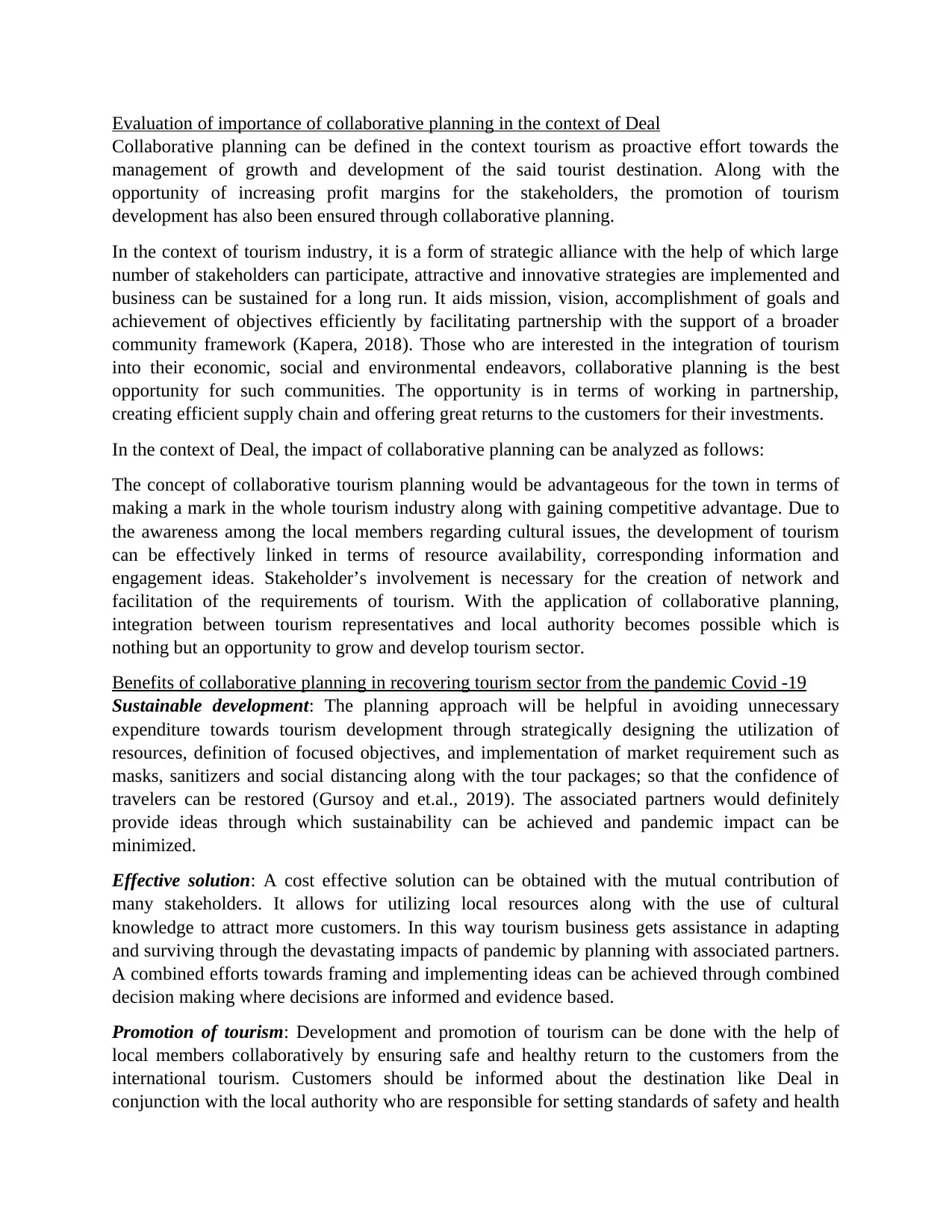
Evaluation of importance of collaborative planning in the context of Deal
Collaborative planning can be defined in the context tourism as proactive effort towards the
management of growth and development of the said tourist destination. Along with the
opportunity of increasing profit margins for the stakeholders, the promotion of tourism
development has also been ensured through collaborative planning.
In the context of tourism industry, it is a form of strategic alliance with the help of which large
number of stakeholders can participate, attractive and innovative strategies are implemented and
business can be sustained for a long run. It aids mission, vision, accomplishment of goals and
achievement of objectives efficiently by facilitating partnership with the support of a broader
community framework (Kapera, 2018). Those who are interested in the integration of tourism
into their economic, social and environmental endeavors, collaborative planning is the best
opportunity for such communities. The opportunity is in terms of working in partnership,
creating efficient supply chain and offering great returns to the customers for their investments.
In the context of Deal, the impact of collaborative planning can be analyzed as follows:
The concept of collaborative tourism planning would be advantageous for the town in terms of
making a mark in the whole tourism industry along with gaining competitive advantage. Due to
the awareness among the local members regarding cultural issues, the development of tourism
can be effectively linked in terms of resource availability, corresponding information and
engagement ideas. Stakeholder’s involvement is necessary for the creation of network and
facilitation of the requirements of tourism. With the application of collaborative planning,
integration between tourism representatives and local authority becomes possible which is
nothing but an opportunity to grow and develop tourism sector.
Benefits of collaborative planning in recovering tourism sector from the pandemic Covid -19
Sustainable development: The planning approach will be helpful in avoiding unnecessary
expenditure towards tourism development through strategically designing the utilization of
resources, definition of focused objectives, and implementation of market requirement such as
masks, sanitizers and social distancing along with the tour packages; so that the confidence of
travelers can be restored (Gursoy and et.al., 2019). The associated partners would definitely
provide ideas through which sustainability can be achieved and pandemic impact can be
minimized.
Effective solution: A cost effective solution can be obtained with the mutual contribution of
many stakeholders. It allows for utilizing local resources along with the use of cultural
knowledge to attract more customers. In this way tourism business gets assistance in adapting
and surviving through the devastating impacts of pandemic by planning with associated partners.
A combined efforts towards framing and implementing ideas can be achieved through combined
decision making where decisions are informed and evidence based.
Promotion of tourism: Development and promotion of tourism can be done with the help of
local members collaboratively by ensuring safe and healthy return to the customers from the
international tourism. Customers should be informed about the destination like Deal in
conjunction with the local authority who are responsible for setting standards of safety and health
Collaborative planning can be defined in the context tourism as proactive effort towards the
management of growth and development of the said tourist destination. Along with the
opportunity of increasing profit margins for the stakeholders, the promotion of tourism
development has also been ensured through collaborative planning.
In the context of tourism industry, it is a form of strategic alliance with the help of which large
number of stakeholders can participate, attractive and innovative strategies are implemented and
business can be sustained for a long run. It aids mission, vision, accomplishment of goals and
achievement of objectives efficiently by facilitating partnership with the support of a broader
community framework (Kapera, 2018). Those who are interested in the integration of tourism
into their economic, social and environmental endeavors, collaborative planning is the best
opportunity for such communities. The opportunity is in terms of working in partnership,
creating efficient supply chain and offering great returns to the customers for their investments.
In the context of Deal, the impact of collaborative planning can be analyzed as follows:
The concept of collaborative tourism planning would be advantageous for the town in terms of
making a mark in the whole tourism industry along with gaining competitive advantage. Due to
the awareness among the local members regarding cultural issues, the development of tourism
can be effectively linked in terms of resource availability, corresponding information and
engagement ideas. Stakeholder’s involvement is necessary for the creation of network and
facilitation of the requirements of tourism. With the application of collaborative planning,
integration between tourism representatives and local authority becomes possible which is
nothing but an opportunity to grow and develop tourism sector.
Benefits of collaborative planning in recovering tourism sector from the pandemic Covid -19
Sustainable development: The planning approach will be helpful in avoiding unnecessary
expenditure towards tourism development through strategically designing the utilization of
resources, definition of focused objectives, and implementation of market requirement such as
masks, sanitizers and social distancing along with the tour packages; so that the confidence of
travelers can be restored (Gursoy and et.al., 2019). The associated partners would definitely
provide ideas through which sustainability can be achieved and pandemic impact can be
minimized.
Effective solution: A cost effective solution can be obtained with the mutual contribution of
many stakeholders. It allows for utilizing local resources along with the use of cultural
knowledge to attract more customers. In this way tourism business gets assistance in adapting
and surviving through the devastating impacts of pandemic by planning with associated partners.
A combined efforts towards framing and implementing ideas can be achieved through combined
decision making where decisions are informed and evidence based.
Promotion of tourism: Development and promotion of tourism can be done with the help of
local members collaboratively by ensuring safe and healthy return to the customers from the
international tourism. Customers should be informed about the destination like Deal in
conjunction with the local authority who are responsible for setting standards of safety and health
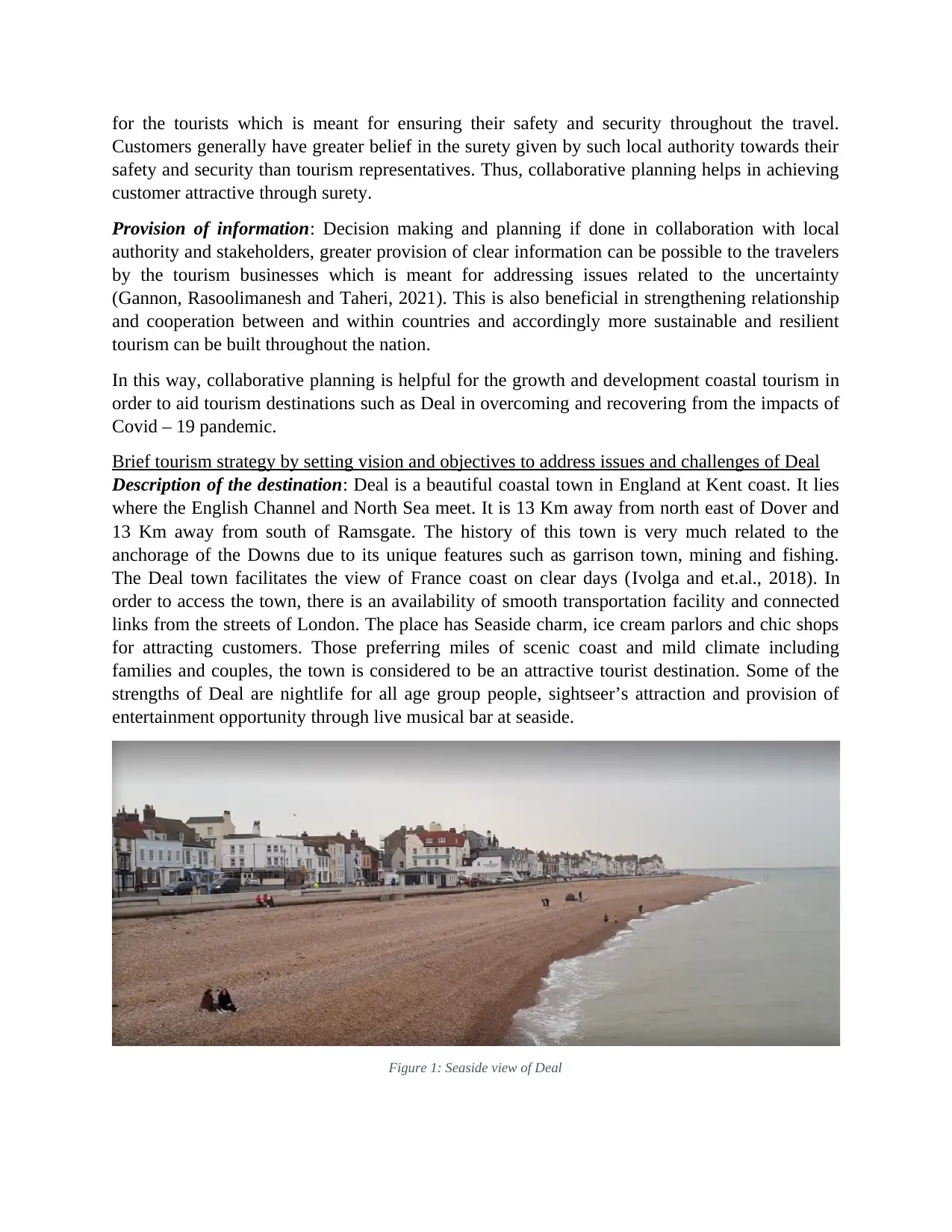
for the tourists which is meant for ensuring their safety and security throughout the travel.
Customers generally have greater belief in the surety given by such local authority towards their
safety and security than tourism representatives. Thus, collaborative planning helps in achieving
customer attractive through surety.
Provision of information: Decision making and planning if done in collaboration with local
authority and stakeholders, greater provision of clear information can be possible to the travelers
by the tourism businesses which is meant for addressing issues related to the uncertainty
(Gannon, Rasoolimanesh and Taheri, 2021). This is also beneficial in strengthening relationship
and cooperation between and within countries and accordingly more sustainable and resilient
tourism can be built throughout the nation.
In this way, collaborative planning is helpful for the growth and development coastal tourism in
order to aid tourism destinations such as Deal in overcoming and recovering from the impacts of
Covid – 19 pandemic.
Brief tourism strategy by setting vision and objectives to address issues and challenges of Deal
Description of the destination: Deal is a beautiful coastal town in England at Kent coast. It lies
where the English Channel and North Sea meet. It is 13 Km away from north east of Dover and
13 Km away from south of Ramsgate. The history of this town is very much related to the
anchorage of the Downs due to its unique features such as garrison town, mining and fishing.
The Deal town facilitates the view of France coast on clear days (Ivolga and et.al., 2018). In
order to access the town, there is an availability of smooth transportation facility and connected
links from the streets of London. The place has Seaside charm, ice cream parlors and chic shops
for attracting customers. Those preferring miles of scenic coast and mild climate including
families and couples, the town is considered to be an attractive tourist destination. Some of the
strengths of Deal are nightlife for all age group people, sightseer’s attraction and provision of
entertainment opportunity through live musical bar at seaside.
Figure 1: Seaside view of Deal
Customers generally have greater belief in the surety given by such local authority towards their
safety and security than tourism representatives. Thus, collaborative planning helps in achieving
customer attractive through surety.
Provision of information: Decision making and planning if done in collaboration with local
authority and stakeholders, greater provision of clear information can be possible to the travelers
by the tourism businesses which is meant for addressing issues related to the uncertainty
(Gannon, Rasoolimanesh and Taheri, 2021). This is also beneficial in strengthening relationship
and cooperation between and within countries and accordingly more sustainable and resilient
tourism can be built throughout the nation.
In this way, collaborative planning is helpful for the growth and development coastal tourism in
order to aid tourism destinations such as Deal in overcoming and recovering from the impacts of
Covid – 19 pandemic.
Brief tourism strategy by setting vision and objectives to address issues and challenges of Deal
Description of the destination: Deal is a beautiful coastal town in England at Kent coast. It lies
where the English Channel and North Sea meet. It is 13 Km away from north east of Dover and
13 Km away from south of Ramsgate. The history of this town is very much related to the
anchorage of the Downs due to its unique features such as garrison town, mining and fishing.
The Deal town facilitates the view of France coast on clear days (Ivolga and et.al., 2018). In
order to access the town, there is an availability of smooth transportation facility and connected
links from the streets of London. The place has Seaside charm, ice cream parlors and chic shops
for attracting customers. Those preferring miles of scenic coast and mild climate including
families and couples, the town is considered to be an attractive tourist destination. Some of the
strengths of Deal are nightlife for all age group people, sightseer’s attraction and provision of
entertainment opportunity through live musical bar at seaside.
Figure 1: Seaside view of Deal
⊘ This is a preview!⊘
Do you want full access?
Subscribe today to unlock all pages.

Trusted by 1+ million students worldwide
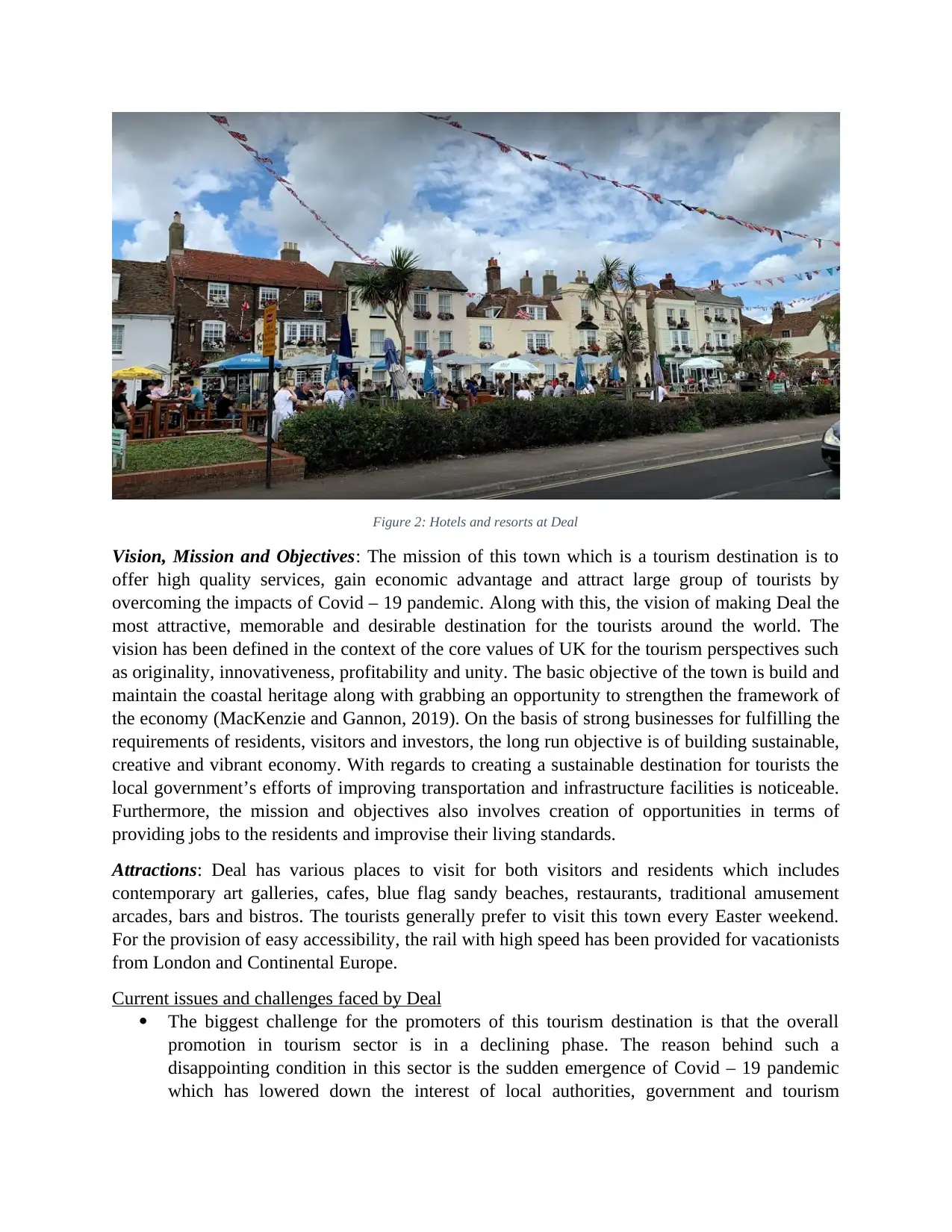
Figure 2: Hotels and resorts at Deal
Vision, Mission and Objectives: The mission of this town which is a tourism destination is to
offer high quality services, gain economic advantage and attract large group of tourists by
overcoming the impacts of Covid – 19 pandemic. Along with this, the vision of making Deal the
most attractive, memorable and desirable destination for the tourists around the world. The
vision has been defined in the context of the core values of UK for the tourism perspectives such
as originality, innovativeness, profitability and unity. The basic objective of the town is build and
maintain the coastal heritage along with grabbing an opportunity to strengthen the framework of
the economy (MacKenzie and Gannon, 2019). On the basis of strong businesses for fulfilling the
requirements of residents, visitors and investors, the long run objective is of building sustainable,
creative and vibrant economy. With regards to creating a sustainable destination for tourists the
local government’s efforts of improving transportation and infrastructure facilities is noticeable.
Furthermore, the mission and objectives also involves creation of opportunities in terms of
providing jobs to the residents and improvise their living standards.
Attractions: Deal has various places to visit for both visitors and residents which includes
contemporary art galleries, cafes, blue flag sandy beaches, restaurants, traditional amusement
arcades, bars and bistros. The tourists generally prefer to visit this town every Easter weekend.
For the provision of easy accessibility, the rail with high speed has been provided for vacationists
from London and Continental Europe.
Current issues and challenges faced by Deal
The biggest challenge for the promoters of this tourism destination is that the overall
promotion in tourism sector is in a declining phase. The reason behind such a
disappointing condition in this sector is the sudden emergence of Covid – 19 pandemic
which has lowered down the interest of local authorities, government and tourism
Vision, Mission and Objectives: The mission of this town which is a tourism destination is to
offer high quality services, gain economic advantage and attract large group of tourists by
overcoming the impacts of Covid – 19 pandemic. Along with this, the vision of making Deal the
most attractive, memorable and desirable destination for the tourists around the world. The
vision has been defined in the context of the core values of UK for the tourism perspectives such
as originality, innovativeness, profitability and unity. The basic objective of the town is build and
maintain the coastal heritage along with grabbing an opportunity to strengthen the framework of
the economy (MacKenzie and Gannon, 2019). On the basis of strong businesses for fulfilling the
requirements of residents, visitors and investors, the long run objective is of building sustainable,
creative and vibrant economy. With regards to creating a sustainable destination for tourists the
local government’s efforts of improving transportation and infrastructure facilities is noticeable.
Furthermore, the mission and objectives also involves creation of opportunities in terms of
providing jobs to the residents and improvise their living standards.
Attractions: Deal has various places to visit for both visitors and residents which includes
contemporary art galleries, cafes, blue flag sandy beaches, restaurants, traditional amusement
arcades, bars and bistros. The tourists generally prefer to visit this town every Easter weekend.
For the provision of easy accessibility, the rail with high speed has been provided for vacationists
from London and Continental Europe.
Current issues and challenges faced by Deal
The biggest challenge for the promoters of this tourism destination is that the overall
promotion in tourism sector is in a declining phase. The reason behind such a
disappointing condition in this sector is the sudden emergence of Covid – 19 pandemic
which has lowered down the interest of local authorities, government and tourism
Paraphrase This Document
Need a fresh take? Get an instant paraphrase of this document with our AI Paraphraser
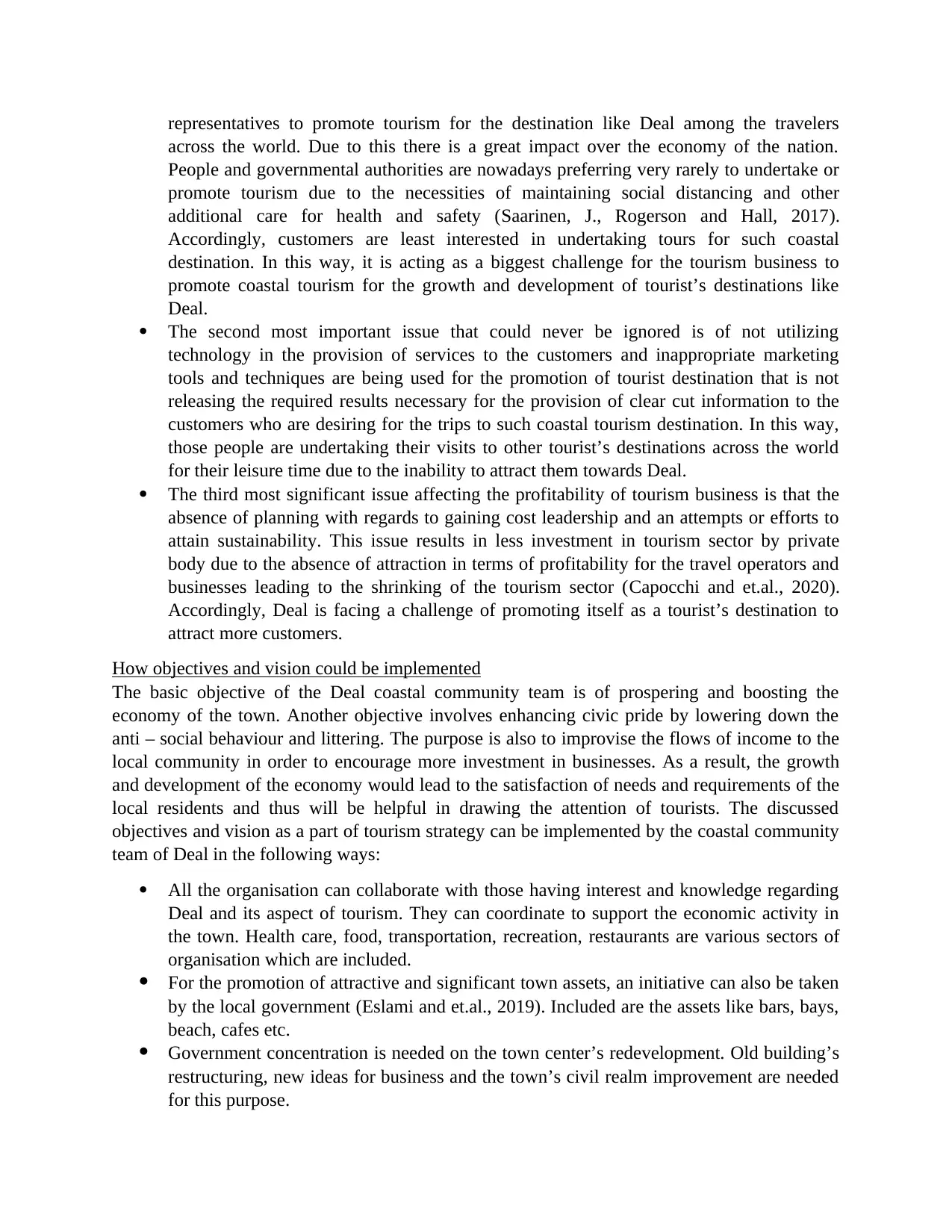
representatives to promote tourism for the destination like Deal among the travelers
across the world. Due to this there is a great impact over the economy of the nation.
People and governmental authorities are nowadays preferring very rarely to undertake or
promote tourism due to the necessities of maintaining social distancing and other
additional care for health and safety (Saarinen, J., Rogerson and Hall, 2017).
Accordingly, customers are least interested in undertaking tours for such coastal
destination. In this way, it is acting as a biggest challenge for the tourism business to
promote coastal tourism for the growth and development of tourist’s destinations like
Deal.
The second most important issue that could never be ignored is of not utilizing
technology in the provision of services to the customers and inappropriate marketing
tools and techniques are being used for the promotion of tourist destination that is not
releasing the required results necessary for the provision of clear cut information to the
customers who are desiring for the trips to such coastal tourism destination. In this way,
those people are undertaking their visits to other tourist’s destinations across the world
for their leisure time due to the inability to attract them towards Deal.
The third most significant issue affecting the profitability of tourism business is that the
absence of planning with regards to gaining cost leadership and an attempts or efforts to
attain sustainability. This issue results in less investment in tourism sector by private
body due to the absence of attraction in terms of profitability for the travel operators and
businesses leading to the shrinking of the tourism sector (Capocchi and et.al., 2020).
Accordingly, Deal is facing a challenge of promoting itself as a tourist’s destination to
attract more customers.
How objectives and vision could be implemented
The basic objective of the Deal coastal community team is of prospering and boosting the
economy of the town. Another objective involves enhancing civic pride by lowering down the
anti – social behaviour and littering. The purpose is also to improvise the flows of income to the
local community in order to encourage more investment in businesses. As a result, the growth
and development of the economy would lead to the satisfaction of needs and requirements of the
local residents and thus will be helpful in drawing the attention of tourists. The discussed
objectives and vision as a part of tourism strategy can be implemented by the coastal community
team of Deal in the following ways:
All the organisation can collaborate with those having interest and knowledge regarding
Deal and its aspect of tourism. They can coordinate to support the economic activity in
the town. Health care, food, transportation, recreation, restaurants are various sectors of
organisation which are included.
For the promotion of attractive and significant town assets, an initiative can also be taken
by the local government (Eslami and et.al., 2019). Included are the assets like bars, bays,
beach, cafes etc.
Government concentration is needed on the town center’s redevelopment. Old building’s
restructuring, new ideas for business and the town’s civil realm improvement are needed
for this purpose.
across the world. Due to this there is a great impact over the economy of the nation.
People and governmental authorities are nowadays preferring very rarely to undertake or
promote tourism due to the necessities of maintaining social distancing and other
additional care for health and safety (Saarinen, J., Rogerson and Hall, 2017).
Accordingly, customers are least interested in undertaking tours for such coastal
destination. In this way, it is acting as a biggest challenge for the tourism business to
promote coastal tourism for the growth and development of tourist’s destinations like
Deal.
The second most important issue that could never be ignored is of not utilizing
technology in the provision of services to the customers and inappropriate marketing
tools and techniques are being used for the promotion of tourist destination that is not
releasing the required results necessary for the provision of clear cut information to the
customers who are desiring for the trips to such coastal tourism destination. In this way,
those people are undertaking their visits to other tourist’s destinations across the world
for their leisure time due to the inability to attract them towards Deal.
The third most significant issue affecting the profitability of tourism business is that the
absence of planning with regards to gaining cost leadership and an attempts or efforts to
attain sustainability. This issue results in less investment in tourism sector by private
body due to the absence of attraction in terms of profitability for the travel operators and
businesses leading to the shrinking of the tourism sector (Capocchi and et.al., 2020).
Accordingly, Deal is facing a challenge of promoting itself as a tourist’s destination to
attract more customers.
How objectives and vision could be implemented
The basic objective of the Deal coastal community team is of prospering and boosting the
economy of the town. Another objective involves enhancing civic pride by lowering down the
anti – social behaviour and littering. The purpose is also to improvise the flows of income to the
local community in order to encourage more investment in businesses. As a result, the growth
and development of the economy would lead to the satisfaction of needs and requirements of the
local residents and thus will be helpful in drawing the attention of tourists. The discussed
objectives and vision as a part of tourism strategy can be implemented by the coastal community
team of Deal in the following ways:
All the organisation can collaborate with those having interest and knowledge regarding
Deal and its aspect of tourism. They can coordinate to support the economic activity in
the town. Health care, food, transportation, recreation, restaurants are various sectors of
organisation which are included.
For the promotion of attractive and significant town assets, an initiative can also be taken
by the local government (Eslami and et.al., 2019). Included are the assets like bars, bays,
beach, cafes etc.
Government concentration is needed on the town center’s redevelopment. Old building’s
restructuring, new ideas for business and the town’s civil realm improvement are needed
for this purpose.
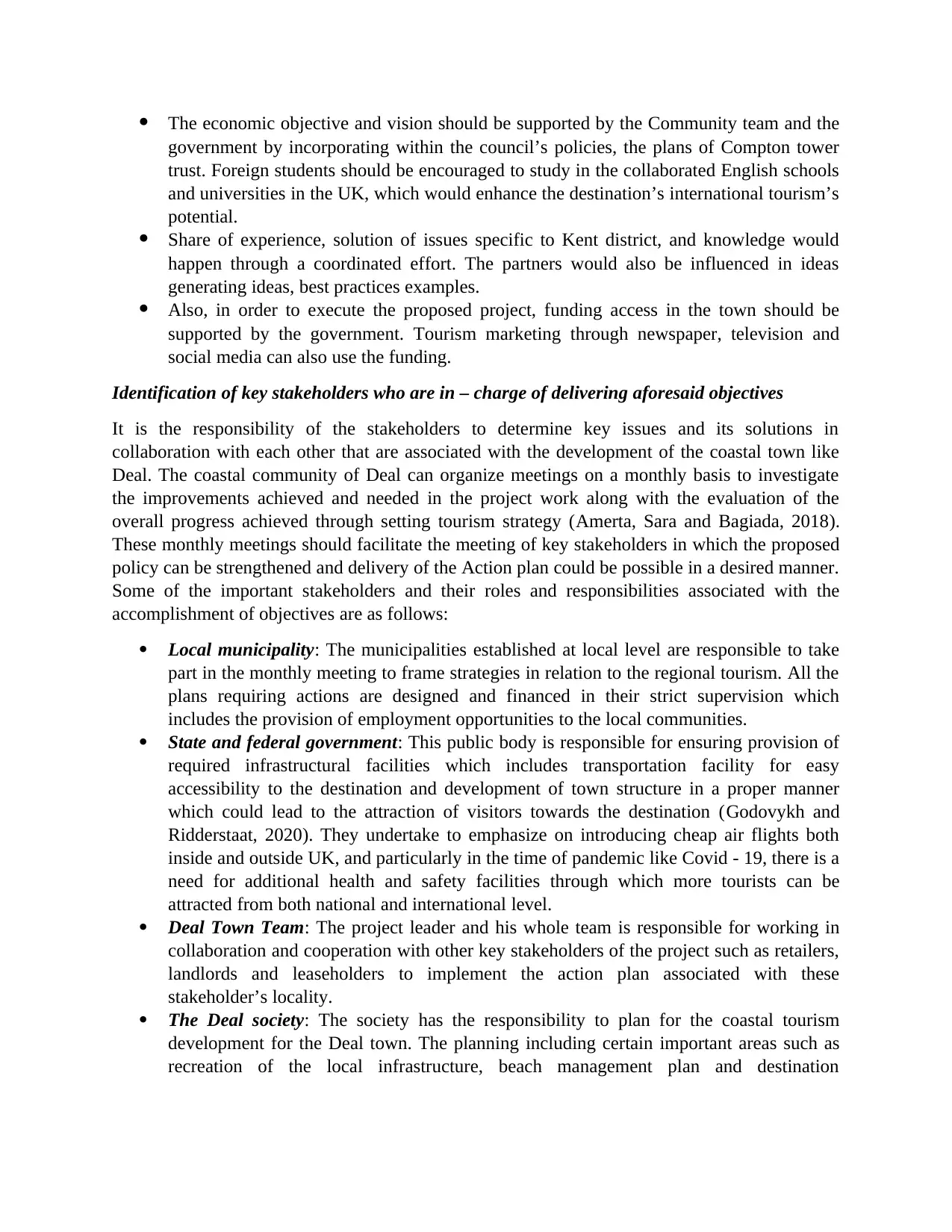
The economic objective and vision should be supported by the Community team and the
government by incorporating within the council’s policies, the plans of Compton tower
trust. Foreign students should be encouraged to study in the collaborated English schools
and universities in the UK, which would enhance the destination’s international tourism’s
potential.
Share of experience, solution of issues specific to Kent district, and knowledge would
happen through a coordinated effort. The partners would also be influenced in ideas
generating ideas, best practices examples.
Also, in order to execute the proposed project, funding access in the town should be
supported by the government. Tourism marketing through newspaper, television and
social media can also use the funding.
Identification of key stakeholders who are in – charge of delivering aforesaid objectives
It is the responsibility of the stakeholders to determine key issues and its solutions in
collaboration with each other that are associated with the development of the coastal town like
Deal. The coastal community of Deal can organize meetings on a monthly basis to investigate
the improvements achieved and needed in the project work along with the evaluation of the
overall progress achieved through setting tourism strategy (Amerta, Sara and Bagiada, 2018).
These monthly meetings should facilitate the meeting of key stakeholders in which the proposed
policy can be strengthened and delivery of the Action plan could be possible in a desired manner.
Some of the important stakeholders and their roles and responsibilities associated with the
accomplishment of objectives are as follows:
Local municipality: The municipalities established at local level are responsible to take
part in the monthly meeting to frame strategies in relation to the regional tourism. All the
plans requiring actions are designed and financed in their strict supervision which
includes the provision of employment opportunities to the local communities.
State and federal government: This public body is responsible for ensuring provision of
required infrastructural facilities which includes transportation facility for easy
accessibility to the destination and development of town structure in a proper manner
which could lead to the attraction of visitors towards the destination (Godovykh and
Ridderstaat, 2020). They undertake to emphasize on introducing cheap air flights both
inside and outside UK, and particularly in the time of pandemic like Covid - 19, there is a
need for additional health and safety facilities through which more tourists can be
attracted from both national and international level.
Deal Town Team: The project leader and his whole team is responsible for working in
collaboration and cooperation with other key stakeholders of the project such as retailers,
landlords and leaseholders to implement the action plan associated with these
stakeholder’s locality.
The Deal society: The society has the responsibility to plan for the coastal tourism
development for the Deal town. The planning including certain important areas such as
recreation of the local infrastructure, beach management plan and destination
government by incorporating within the council’s policies, the plans of Compton tower
trust. Foreign students should be encouraged to study in the collaborated English schools
and universities in the UK, which would enhance the destination’s international tourism’s
potential.
Share of experience, solution of issues specific to Kent district, and knowledge would
happen through a coordinated effort. The partners would also be influenced in ideas
generating ideas, best practices examples.
Also, in order to execute the proposed project, funding access in the town should be
supported by the government. Tourism marketing through newspaper, television and
social media can also use the funding.
Identification of key stakeholders who are in – charge of delivering aforesaid objectives
It is the responsibility of the stakeholders to determine key issues and its solutions in
collaboration with each other that are associated with the development of the coastal town like
Deal. The coastal community of Deal can organize meetings on a monthly basis to investigate
the improvements achieved and needed in the project work along with the evaluation of the
overall progress achieved through setting tourism strategy (Amerta, Sara and Bagiada, 2018).
These monthly meetings should facilitate the meeting of key stakeholders in which the proposed
policy can be strengthened and delivery of the Action plan could be possible in a desired manner.
Some of the important stakeholders and their roles and responsibilities associated with the
accomplishment of objectives are as follows:
Local municipality: The municipalities established at local level are responsible to take
part in the monthly meeting to frame strategies in relation to the regional tourism. All the
plans requiring actions are designed and financed in their strict supervision which
includes the provision of employment opportunities to the local communities.
State and federal government: This public body is responsible for ensuring provision of
required infrastructural facilities which includes transportation facility for easy
accessibility to the destination and development of town structure in a proper manner
which could lead to the attraction of visitors towards the destination (Godovykh and
Ridderstaat, 2020). They undertake to emphasize on introducing cheap air flights both
inside and outside UK, and particularly in the time of pandemic like Covid - 19, there is a
need for additional health and safety facilities through which more tourists can be
attracted from both national and international level.
Deal Town Team: The project leader and his whole team is responsible for working in
collaboration and cooperation with other key stakeholders of the project such as retailers,
landlords and leaseholders to implement the action plan associated with these
stakeholder’s locality.
The Deal society: The society has the responsibility to plan for the coastal tourism
development for the Deal town. The planning including certain important areas such as
recreation of the local infrastructure, beach management plan and destination
⊘ This is a preview!⊘
Do you want full access?
Subscribe today to unlock all pages.

Trusted by 1+ million students worldwide
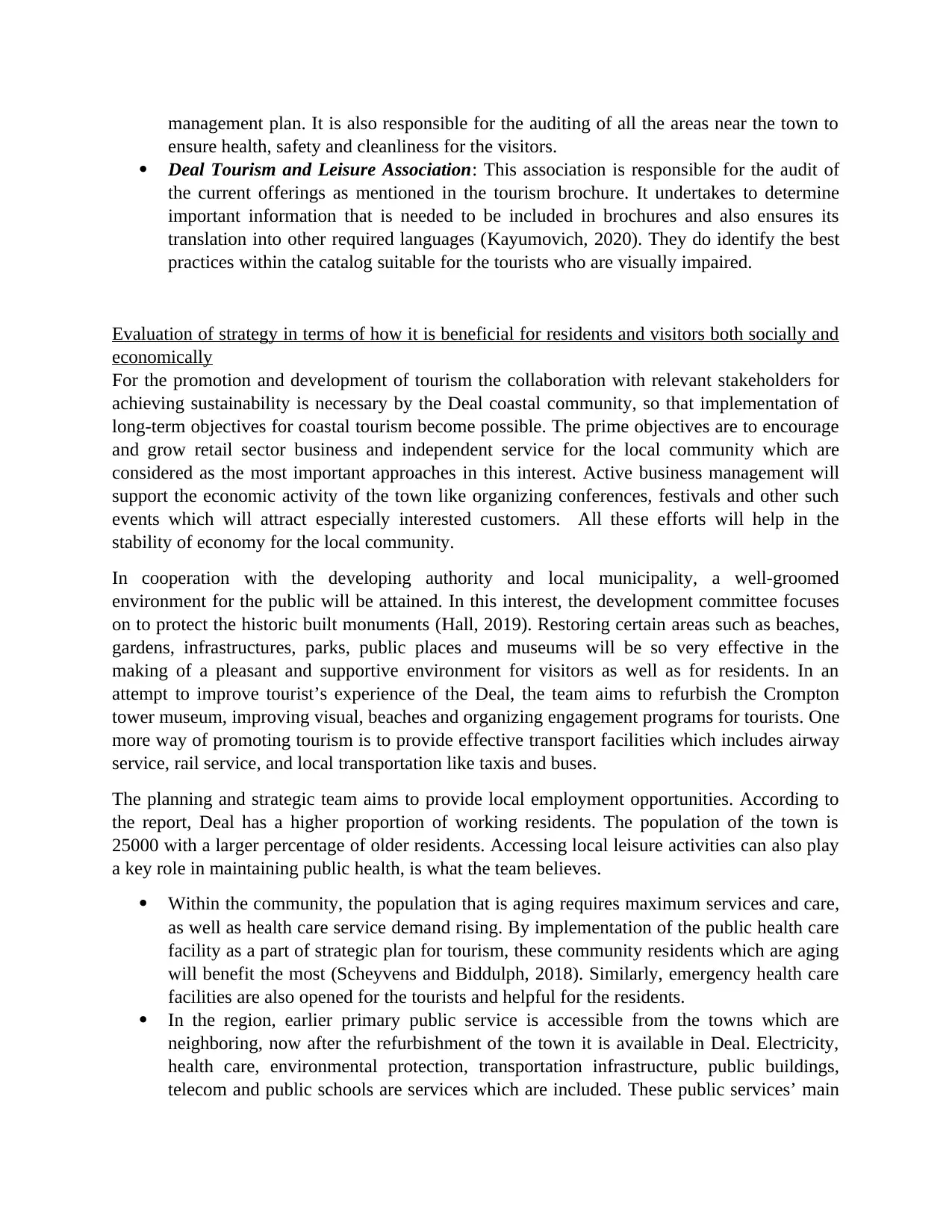
management plan. It is also responsible for the auditing of all the areas near the town to
ensure health, safety and cleanliness for the visitors.
Deal Tourism and Leisure Association: This association is responsible for the audit of
the current offerings as mentioned in the tourism brochure. It undertakes to determine
important information that is needed to be included in brochures and also ensures its
translation into other required languages (Kayumovich, 2020). They do identify the best
practices within the catalog suitable for the tourists who are visually impaired.
Evaluation of strategy in terms of how it is beneficial for residents and visitors both socially and
economically
For the promotion and development of tourism the collaboration with relevant stakeholders for
achieving sustainability is necessary by the Deal coastal community, so that implementation of
long-term objectives for coastal tourism become possible. The prime objectives are to encourage
and grow retail sector business and independent service for the local community which are
considered as the most important approaches in this interest. Active business management will
support the economic activity of the town like organizing conferences, festivals and other such
events which will attract especially interested customers. All these efforts will help in the
stability of economy for the local community.
In cooperation with the developing authority and local municipality, a well-groomed
environment for the public will be attained. In this interest, the development committee focuses
on to protect the historic built monuments (Hall, 2019). Restoring certain areas such as beaches,
gardens, infrastructures, parks, public places and museums will be so very effective in the
making of a pleasant and supportive environment for visitors as well as for residents. In an
attempt to improve tourist’s experience of the Deal, the team aims to refurbish the Crompton
tower museum, improving visual, beaches and organizing engagement programs for tourists. One
more way of promoting tourism is to provide effective transport facilities which includes airway
service, rail service, and local transportation like taxis and buses.
The planning and strategic team aims to provide local employment opportunities. According to
the report, Deal has a higher proportion of working residents. The population of the town is
25000 with a larger percentage of older residents. Accessing local leisure activities can also play
a key role in maintaining public health, is what the team believes.
Within the community, the population that is aging requires maximum services and care,
as well as health care service demand rising. By implementation of the public health care
facility as a part of strategic plan for tourism, these community residents which are aging
will benefit the most (Scheyvens and Biddulph, 2018). Similarly, emergency health care
facilities are also opened for the tourists and helpful for the residents.
In the region, earlier primary public service is accessible from the towns which are
neighboring, now after the refurbishment of the town it is available in Deal. Electricity,
health care, environmental protection, transportation infrastructure, public buildings,
telecom and public schools are services which are included. These public services’ main
ensure health, safety and cleanliness for the visitors.
Deal Tourism and Leisure Association: This association is responsible for the audit of
the current offerings as mentioned in the tourism brochure. It undertakes to determine
important information that is needed to be included in brochures and also ensures its
translation into other required languages (Kayumovich, 2020). They do identify the best
practices within the catalog suitable for the tourists who are visually impaired.
Evaluation of strategy in terms of how it is beneficial for residents and visitors both socially and
economically
For the promotion and development of tourism the collaboration with relevant stakeholders for
achieving sustainability is necessary by the Deal coastal community, so that implementation of
long-term objectives for coastal tourism become possible. The prime objectives are to encourage
and grow retail sector business and independent service for the local community which are
considered as the most important approaches in this interest. Active business management will
support the economic activity of the town like organizing conferences, festivals and other such
events which will attract especially interested customers. All these efforts will help in the
stability of economy for the local community.
In cooperation with the developing authority and local municipality, a well-groomed
environment for the public will be attained. In this interest, the development committee focuses
on to protect the historic built monuments (Hall, 2019). Restoring certain areas such as beaches,
gardens, infrastructures, parks, public places and museums will be so very effective in the
making of a pleasant and supportive environment for visitors as well as for residents. In an
attempt to improve tourist’s experience of the Deal, the team aims to refurbish the Crompton
tower museum, improving visual, beaches and organizing engagement programs for tourists. One
more way of promoting tourism is to provide effective transport facilities which includes airway
service, rail service, and local transportation like taxis and buses.
The planning and strategic team aims to provide local employment opportunities. According to
the report, Deal has a higher proportion of working residents. The population of the town is
25000 with a larger percentage of older residents. Accessing local leisure activities can also play
a key role in maintaining public health, is what the team believes.
Within the community, the population that is aging requires maximum services and care,
as well as health care service demand rising. By implementation of the public health care
facility as a part of strategic plan for tourism, these community residents which are aging
will benefit the most (Scheyvens and Biddulph, 2018). Similarly, emergency health care
facilities are also opened for the tourists and helpful for the residents.
In the region, earlier primary public service is accessible from the towns which are
neighboring, now after the refurbishment of the town it is available in Deal. Electricity,
health care, environmental protection, transportation infrastructure, public buildings,
telecom and public schools are services which are included. These public services’ main
Paraphrase This Document
Need a fresh take? Get an instant paraphrase of this document with our AI Paraphraser
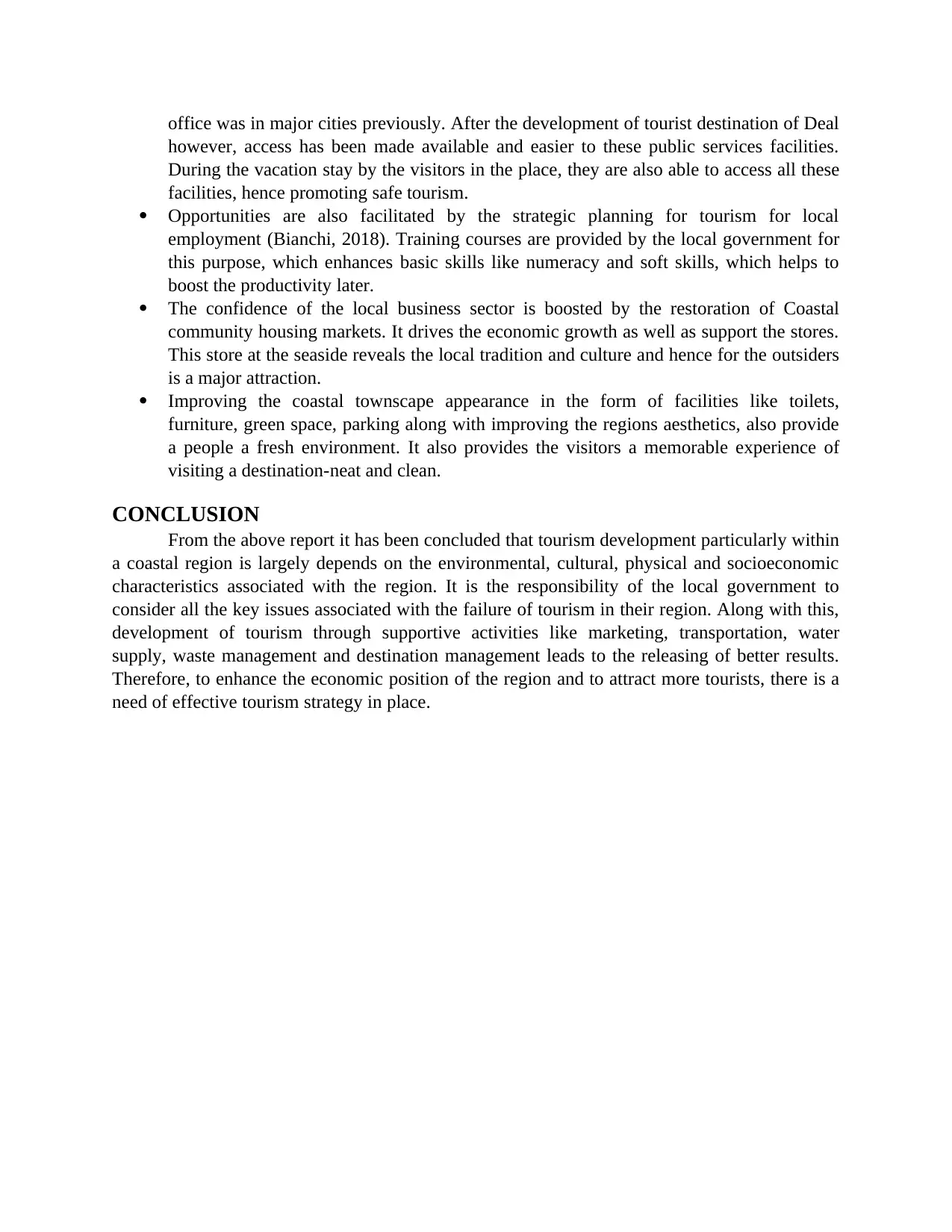
office was in major cities previously. After the development of tourist destination of Deal
however, access has been made available and easier to these public services facilities.
During the vacation stay by the visitors in the place, they are also able to access all these
facilities, hence promoting safe tourism.
Opportunities are also facilitated by the strategic planning for tourism for local
employment (Bianchi, 2018). Training courses are provided by the local government for
this purpose, which enhances basic skills like numeracy and soft skills, which helps to
boost the productivity later.
The confidence of the local business sector is boosted by the restoration of Coastal
community housing markets. It drives the economic growth as well as support the stores.
This store at the seaside reveals the local tradition and culture and hence for the outsiders
is a major attraction.
Improving the coastal townscape appearance in the form of facilities like toilets,
furniture, green space, parking along with improving the regions aesthetics, also provide
a people a fresh environment. It also provides the visitors a memorable experience of
visiting a destination-neat and clean.
CONCLUSION
From the above report it has been concluded that tourism development particularly within
a coastal region is largely depends on the environmental, cultural, physical and socioeconomic
characteristics associated with the region. It is the responsibility of the local government to
consider all the key issues associated with the failure of tourism in their region. Along with this,
development of tourism through supportive activities like marketing, transportation, water
supply, waste management and destination management leads to the releasing of better results.
Therefore, to enhance the economic position of the region and to attract more tourists, there is a
need of effective tourism strategy in place.
however, access has been made available and easier to these public services facilities.
During the vacation stay by the visitors in the place, they are also able to access all these
facilities, hence promoting safe tourism.
Opportunities are also facilitated by the strategic planning for tourism for local
employment (Bianchi, 2018). Training courses are provided by the local government for
this purpose, which enhances basic skills like numeracy and soft skills, which helps to
boost the productivity later.
The confidence of the local business sector is boosted by the restoration of Coastal
community housing markets. It drives the economic growth as well as support the stores.
This store at the seaside reveals the local tradition and culture and hence for the outsiders
is a major attraction.
Improving the coastal townscape appearance in the form of facilities like toilets,
furniture, green space, parking along with improving the regions aesthetics, also provide
a people a fresh environment. It also provides the visitors a memorable experience of
visiting a destination-neat and clean.
CONCLUSION
From the above report it has been concluded that tourism development particularly within
a coastal region is largely depends on the environmental, cultural, physical and socioeconomic
characteristics associated with the region. It is the responsibility of the local government to
consider all the key issues associated with the failure of tourism in their region. Along with this,
development of tourism through supportive activities like marketing, transportation, water
supply, waste management and destination management leads to the releasing of better results.
Therefore, to enhance the economic position of the region and to attract more tourists, there is a
need of effective tourism strategy in place.
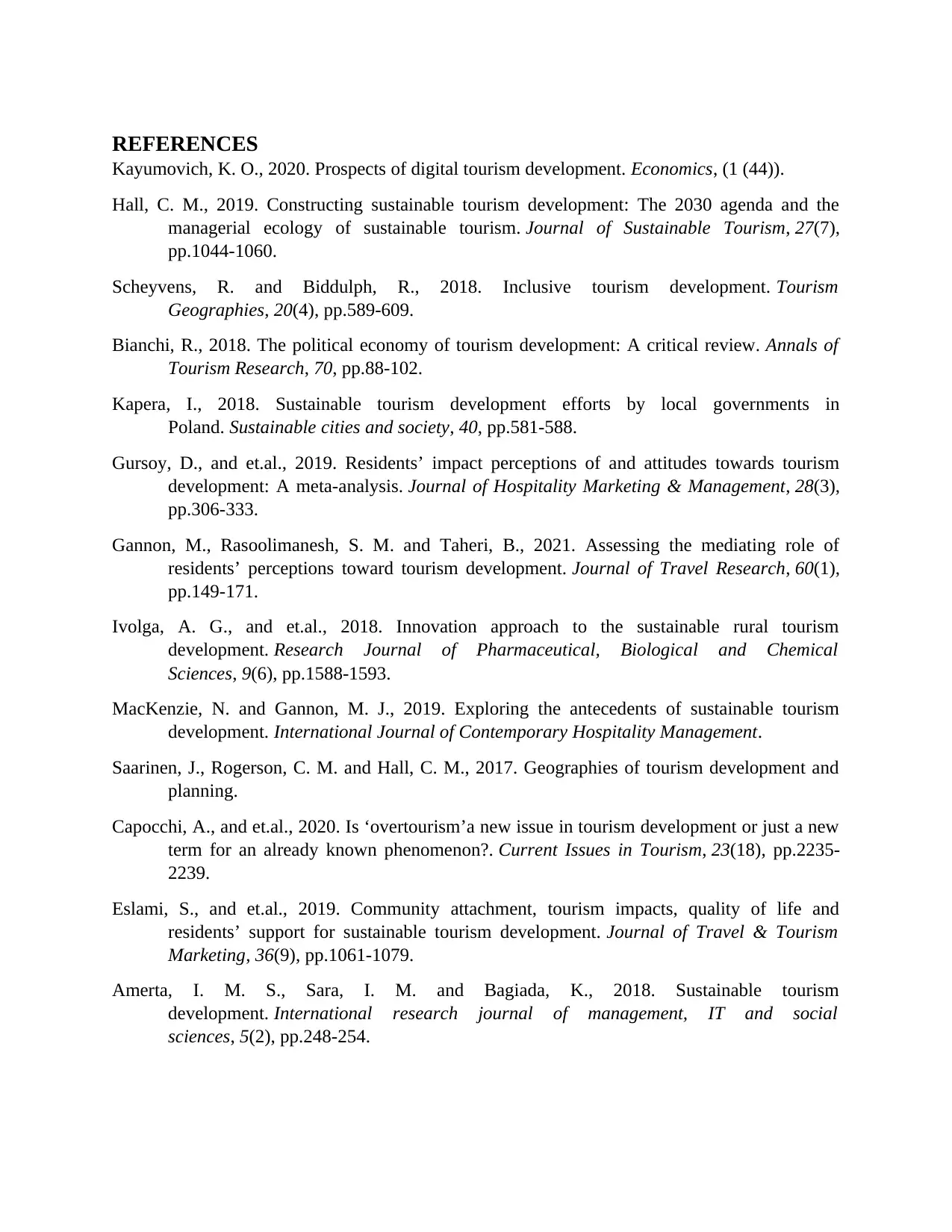
REFERENCES
Kayumovich, K. O., 2020. Prospects of digital tourism development. Economics, (1 (44)).
Hall, C. M., 2019. Constructing sustainable tourism development: The 2030 agenda and the
managerial ecology of sustainable tourism. Journal of Sustainable Tourism, 27(7),
pp.1044-1060.
Scheyvens, R. and Biddulph, R., 2018. Inclusive tourism development. Tourism
Geographies, 20(4), pp.589-609.
Bianchi, R., 2018. The political economy of tourism development: A critical review. Annals of
Tourism Research, 70, pp.88-102.
Kapera, I., 2018. Sustainable tourism development efforts by local governments in
Poland. Sustainable cities and society, 40, pp.581-588.
Gursoy, D., and et.al., 2019. Residents’ impact perceptions of and attitudes towards tourism
development: A meta-analysis. Journal of Hospitality Marketing & Management, 28(3),
pp.306-333.
Gannon, M., Rasoolimanesh, S. M. and Taheri, B., 2021. Assessing the mediating role of
residents’ perceptions toward tourism development. Journal of Travel Research, 60(1),
pp.149-171.
Ivolga, A. G., and et.al., 2018. Innovation approach to the sustainable rural tourism
development. Research Journal of Pharmaceutical, Biological and Chemical
Sciences, 9(6), pp.1588-1593.
MacKenzie, N. and Gannon, M. J., 2019. Exploring the antecedents of sustainable tourism
development. International Journal of Contemporary Hospitality Management.
Saarinen, J., Rogerson, C. M. and Hall, C. M., 2017. Geographies of tourism development and
planning.
Capocchi, A., and et.al., 2020. Is ‘overtourism’a new issue in tourism development or just a new
term for an already known phenomenon?. Current Issues in Tourism, 23(18), pp.2235-
2239.
Eslami, S., and et.al., 2019. Community attachment, tourism impacts, quality of life and
residents’ support for sustainable tourism development. Journal of Travel & Tourism
Marketing, 36(9), pp.1061-1079.
Amerta, I. M. S., Sara, I. M. and Bagiada, K., 2018. Sustainable tourism
development. International research journal of management, IT and social
sciences, 5(2), pp.248-254.
Kayumovich, K. O., 2020. Prospects of digital tourism development. Economics, (1 (44)).
Hall, C. M., 2019. Constructing sustainable tourism development: The 2030 agenda and the
managerial ecology of sustainable tourism. Journal of Sustainable Tourism, 27(7),
pp.1044-1060.
Scheyvens, R. and Biddulph, R., 2018. Inclusive tourism development. Tourism
Geographies, 20(4), pp.589-609.
Bianchi, R., 2018. The political economy of tourism development: A critical review. Annals of
Tourism Research, 70, pp.88-102.
Kapera, I., 2018. Sustainable tourism development efforts by local governments in
Poland. Sustainable cities and society, 40, pp.581-588.
Gursoy, D., and et.al., 2019. Residents’ impact perceptions of and attitudes towards tourism
development: A meta-analysis. Journal of Hospitality Marketing & Management, 28(3),
pp.306-333.
Gannon, M., Rasoolimanesh, S. M. and Taheri, B., 2021. Assessing the mediating role of
residents’ perceptions toward tourism development. Journal of Travel Research, 60(1),
pp.149-171.
Ivolga, A. G., and et.al., 2018. Innovation approach to the sustainable rural tourism
development. Research Journal of Pharmaceutical, Biological and Chemical
Sciences, 9(6), pp.1588-1593.
MacKenzie, N. and Gannon, M. J., 2019. Exploring the antecedents of sustainable tourism
development. International Journal of Contemporary Hospitality Management.
Saarinen, J., Rogerson, C. M. and Hall, C. M., 2017. Geographies of tourism development and
planning.
Capocchi, A., and et.al., 2020. Is ‘overtourism’a new issue in tourism development or just a new
term for an already known phenomenon?. Current Issues in Tourism, 23(18), pp.2235-
2239.
Eslami, S., and et.al., 2019. Community attachment, tourism impacts, quality of life and
residents’ support for sustainable tourism development. Journal of Travel & Tourism
Marketing, 36(9), pp.1061-1079.
Amerta, I. M. S., Sara, I. M. and Bagiada, K., 2018. Sustainable tourism
development. International research journal of management, IT and social
sciences, 5(2), pp.248-254.
⊘ This is a preview!⊘
Do you want full access?
Subscribe today to unlock all pages.

Trusted by 1+ million students worldwide
1 out of 13
Related Documents
Your All-in-One AI-Powered Toolkit for Academic Success.
+13062052269
info@desklib.com
Available 24*7 on WhatsApp / Email
![[object Object]](/_next/static/media/star-bottom.7253800d.svg)
Unlock your academic potential
Copyright © 2020–2025 A2Z Services. All Rights Reserved. Developed and managed by ZUCOL.





